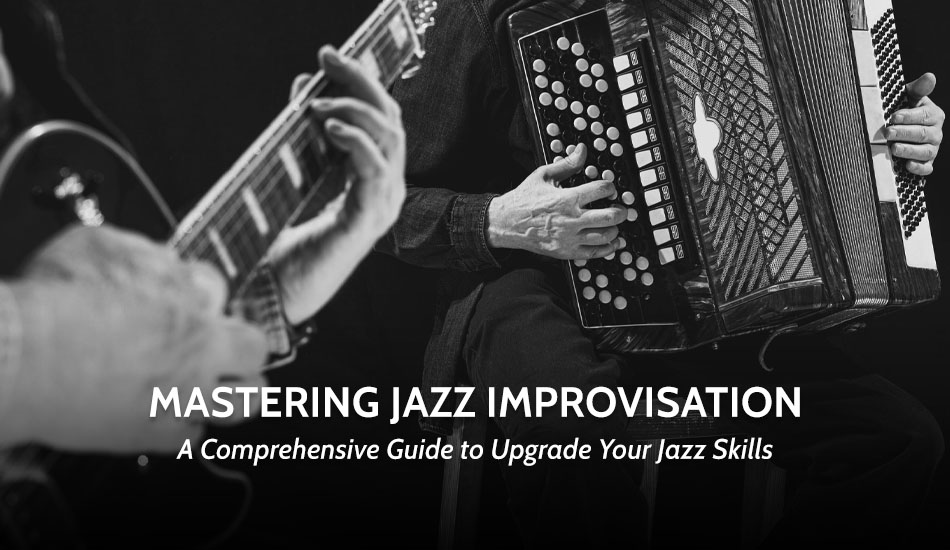Any musician wanting to be more creative and be an individual must learn the skill of Jazz Improvisation. It provides a means for the spontaneous musical expression of the modern jazz singer to express emotion or to express an idea in real time. Even if you’ve dabbled in jazz before, learning the foundations of jazz improvisation can be a game changer both as a new and veteran player. In this complete learning guide, we will discover the basic tools of jazz harmony, functional approaches, and implementing effective practice strategies to help you become a confident improviser.
Jazz Harmony
Jazz harmony underlies a true understanding of jazz improvisation. The framework for the spontaneous musical ideas that musicians can create through Harmony. Beyond that, having a strong understanding of harmony will help you see your way through complicated chord changes and assist you in speaking musically with other players.
Step 1: Basic 7th Chords (The Building Blocks of Jazz Music)
If you are about to pay your attention to jazz improvisation, you must first get acquainted with 7th Chords. The chords in these patterns are very important in jazz and form the basis of other harmonic structures. Here’s a breakdown of the primary types of 7th chords:
- Major 7th Chords: It can be root (Cmaj 7: C E G B) with third (C maj 7: C E G B), perfect fifth (Cmaj 7: C E G B), and major seventh (Cmaj 7: C E G B).
- Minor 7th Chords: It consists of a root, minor third, perfect fifth, and minor seventh (e.g., Cm7: C-Eb-G-Bb).
- Dominant 7th Chords: The root, major third, perfect fifth, and minor seventh (C7: C E G Bb) may or may not be considered to form the basic chord progression.
- Diminished 7th Chords: It contains a root, minor third, diminished fifth, and diminished seventh (e.g., Cdim7: C-Eb-Gb-B).
Playing these 7th chords in various keys and inversions will prepare you for your improvisation and get you tuned in to the harmony.
Step 2: Scales (aka. Pitch Collections)
Once you have 7th chords down, you move on to learning different scales. Without scales, we have literally no way of improvising; they’re important because they are the notes you can play over chords. Here are some essential scales to master:
- Major Scale: The foundation for much of Western music, consisting of seven notes (e.g., C Major: C-D-E-F-G-A-B).
- Minor Scale: It sounds darker because of the seven notes (A Minor: A-B C D E F G).
- Pentatonic Scale: A nice five-note scale that fits well over a lot of chord progressions (e.g., C Pentatonic: C, D, E, G, A).
- Blues Scale: Another name for a pentatonic scale with an ‘added blue’ note (for example, the C Blues Scale: C-Eb-F-F#-G-Bb).
As you explore these scales, practice playing them over different chords and progressions to see how they fit harmonically. This exploration will greatly enhance your jazz improvisation skills.
Step 3: Guide Tones and Voice Leadin
Guide tones: Guide tones in jazz are a description of those essential notes that distinguish a chord’s character. The 3rd and 7th degrees of the chord are pretty common in these notes. These notes can be used to focus on since playing them will help you create a smooth transition from one chord to another, and, in turn, your improvisation will sound more cohesive.
Voice Leading Techniques: Voice leading is the act of moving smoothly from one chord to the other—not jumping, but rather going from one to another—without too much distance between notes. The sound created from this is more fluid and connected. Let’s use an example: say you’re moving from a Cmaj7 to an Am7 chord, the E (3rd of Cmaj7) resolves to the C (root of Am7) and B (7th of Cmaj7) to the A (root of Am7).
By learning the basic foundation of melody voice leading, you will be able to make melodic and harmonically rich lines.
Step #4: Jazz Chord Progressions
Jazz’s chord progressions are its own thing. By learning common progressions, you will become more familiar with what’s about to come and, most importantly, be able to improvise upon the changes you hear. Here are a few common progressions to practice:
- ii-V-I Progression: Its most common progression moving from the tonic (I) to the relative minor (vi), to the minor (ii), to dominant (V) is a popular progression in many standards. In C Major: Cmaj7-Am7-Dm7-G7.
- I-vi-ii-V Progression: A popular progression used in many standards, moving from the tonic (I) to the relative minor (vi), then to the minor (ii) and dominant (V). In C Major: Cmaj7-Am7-Dm7-G7.
- Cycle of Fifths: The chord moving through the cycle of fifths as a progression creates sweeping harmonic movement. For example, C-F-Bb-Eb-Ab-Db.
By practicing these progressions and improvising over them, you will gain confidence in navigating various harmonic landscapes.

Jazz Improvisation
With that under your belt, you’re ready to go beyond that and get into various techniques to take your jazz improvising to the next level.
Setting Up Your Jazz Practice Sessions for Success
To improve it is essential to create an effective practice routine. Here are some tips for setting up your practice sessions:
- Define Your Goals: Decide, in advance, what your goals will be for each practice session. No matter what, when you have clear goals, you will stay focused.
- Balance Your Focus: Set aside some time to practice different things like technique, repertoire, and language of jazz improvisation. For example, the scale for 20 minutes, a jazz standard for 20 minutes, and 20 minutes on improvisation exercises.
- Use a Metronome: Once you get a grasp of jazz break, practicing with a metronome will give you a sense of timing and rhythm to develop, very important for jazz musicians.
“The Big 3” Things You Need to Practice to Improve as a Jazz Improviser
- Technique: Developing your technical skills is vital for fluid improvisation. Regularly practice scales, arpeggios, and specific exercises to build dexterity and strength in your playing. Include finger exercises, interval training, and alternate picking to enhance your overall technique.
- Jazz Repertoire: Expanding your repertoire by learning jazz standards will provide you with various contexts for improvisation. Aim to learn at least 10-15 standards that you can play comfortably. Pay attention to the melodies, harmonies, and common progressions within these pieces.
- Jazz Language: Immerse yourself in the jazz language by transcribing solos from great musicians. Focus on iconic players such as Charlie Parker, John Coltrane, and Miles Davis. Analyzing their phrasing, rhythm, and vocabulary will help you understand how to build your improvisational voice.
Creating an Action Plan for Quicker Jazz Improvement
To expedite your progress, create a structured action plan that includes:
- Daily Practice Schedule: Dedicate specific time slots each day for practice, ensuring a consistent routine.
- Short-Term and Long-Term Goals: Set achievable short-term goals (e.g., learning a specific scale) and long-term goals (e.g., performing a jazz standard confidently).
- Track Your Progress: Keep a practice journal to record what you’ve worked on, what you’ve achieved, and areas for improvement. This will help you stay motivated and accountable.
LEARN HOW TO IMPROVISE ON YOUR FIRST JAZZ STANDARD
To apply everything you’ve learned, choose a simple jazz standard and start improvising. Begin by playing the melody until you feel comfortable, then move on to improvising over the chord changes. Here’s a step-by-step approach:
- Analyze the Song Structure: Familiarize yourself with the form, key, and chord changes. Understanding the structure will help you navigate the piece more effectively.
- Outline the Chord Changes: Write down the chord changes and identify which scales work over each chord. This will serve as a reference while you improvise.
- Experiment with Simple Ideas: Start with simple phrases and motifs, gradually building complexity as you become more comfortable. Don’t be afraid to repeat phrases or play with rhythm and dynamics.
- Record Yourself: Recording your practice sessions can provide valuable feedback and help you identify areas for improvement. Listen back to your improvisation and take note of what works and what doesn’t.
- Seek Feedback: Share your improvisation with peers or mentors and ask for constructive criticism. Engaging with other musicians will provide new insights and perspectives.
Conclusion
Mastering jazz improvisation takes time, dedication, and practice, but the rewards are immense. By understanding jazz harmony, practicing essential techniques, and developing a solid action plan, you will become a more confident and expressive musician.
Remember, the journey of improvisation is a continuous learning experience, so embrace the challenges and celebrate your progress. With persistence and passion, you can unlock the true potential of your musical expression through jazz! Don’t forget to explore jazz music songs for inspiration, and keep an ear out for a new jazz album to push your skills further!




